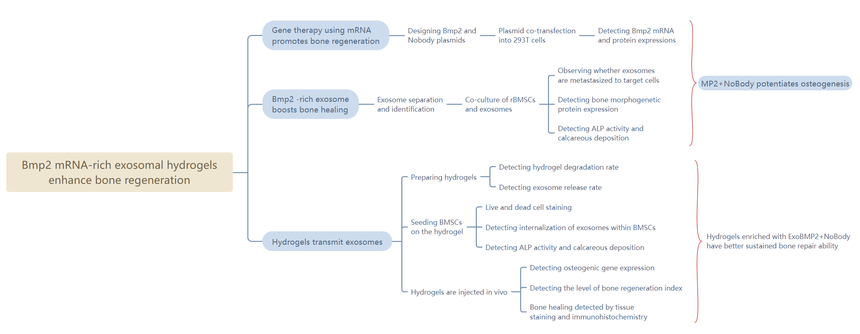Please click the button below to go to our email login page
|
IF of 10.6! “Exosome+Hydrogel”, an outstanding combination revealing bone regeneration mechanismAs is well-known, bone is an important organ in the human body, responsible for supporting movements and protecting organs. The bone tissue defect may occur in response to trauma, infection, tumor resection or congenital diseases. Bone defect is often accompanied with damaged muscle, tendon and joint. Bone tissues have a natural healing ability, but the regenerative process is complicated under the control of multiple physiological pathways and involving many cells and molecules. When bone defect is too severe to be cured by natural healing ability, clinical intervention is necessary. Then, what are specific research thoughts regarding bone regeneration? Next, we will share a paper entitled Hydrogel armed with Bmp2 mRNA-enriched exosomes enhances bone regeneration, published in Journal of Nanobiotechnology with an IF of 10.6, hoping to inspire you.
1. Research background (1) Transgenic cells synthesize BMP2 in the defective bone region and promote bone healing. (2) Gene therapy using mRNA has numerous advantages in treating bone defects over classical gene therapy using DNA. (3) Exosomes have been increasingly used for diagnosing and treating diseases due to its ideal natural structure and characteristics. (4) Exosomes rich in BMP2 can promote bone healing. (5) Hydrogel can serve as a delivery system and scaffold of exosomes to facilitate continuous release of engineered exosomes.
2. Technical route
3. Research results (1) Characteristics of Bmp2 mRNA-rich engineered exosomes (2) ExoBMP2+NoBody enhances osteogenesis (3) Properties of GM-90-CP05+Exo hydrogels (4) GM-90-CP05 hydrogel with encapsulation of ExoBMP2+NoBody enhances osteogenesis in vitro (5) In vivo GM-90-CP05 hydrogel delivery of ExoBMP2+NoBody promotes calvarial bone healing
4. Conclusion The researchers enrich the exosomes with Bmp2 mRNA by selective inhibition of translation in donor cells, and co-transfect NoBody and modified engineered BMP2 plasmids into the cells, ultimately obtaining exosomes named ExoBMP2+NoBody. Then, the in vitro experiments verified that ExoBMP2+NoBody has higher abundance of Bmp2 mRNA and thus has stronger osteogenic induction capacity. When loaded into GelMA hydrogel via allyl-L-glycine-CP05, the exosomes could be slowly released to ensure their prolonged effect on bones. Finally, in in vivo calvarial defect model, ExoBMP2+NoBody-loaded GelMA exhibits strong effects on promoting bone regeneration. Collectively, ExoBMP2+NoBody-loaded GelMA can act as a highly effective and innovative strategy for bone regeneration. |


